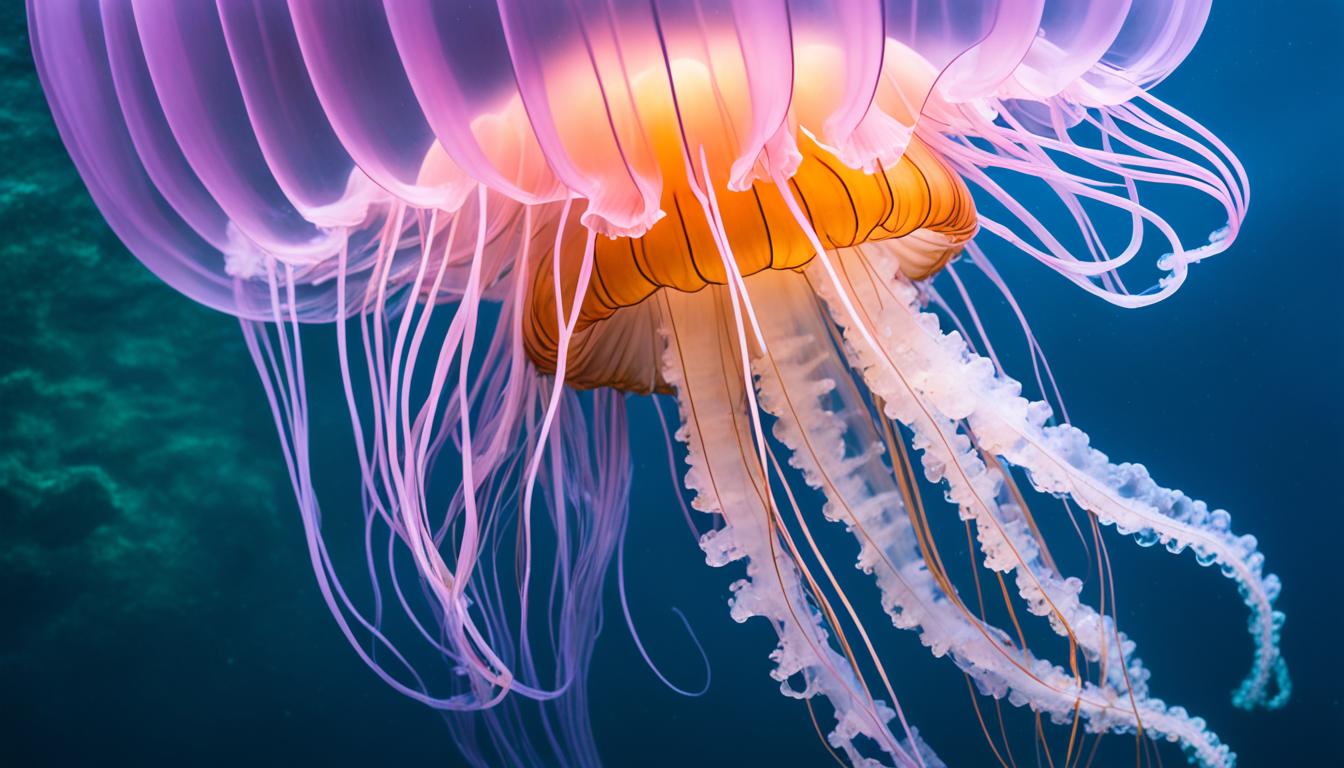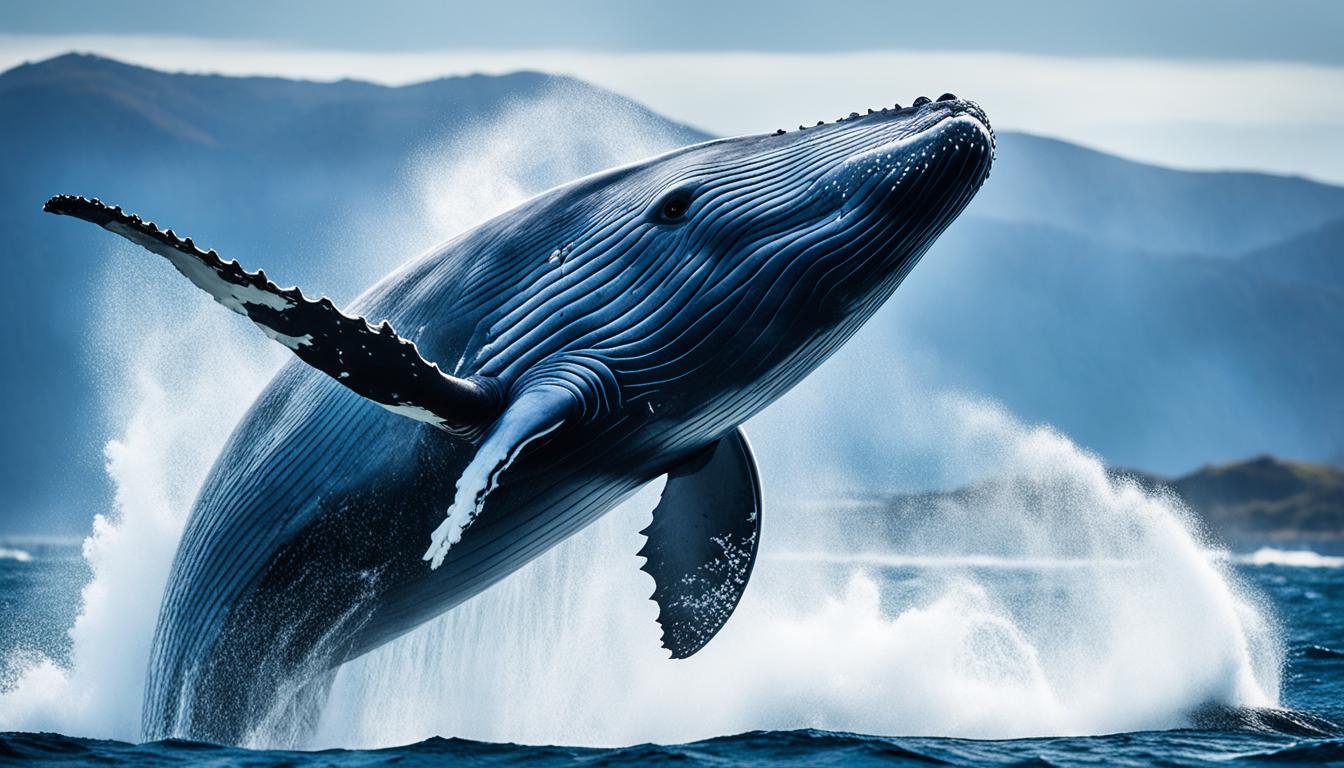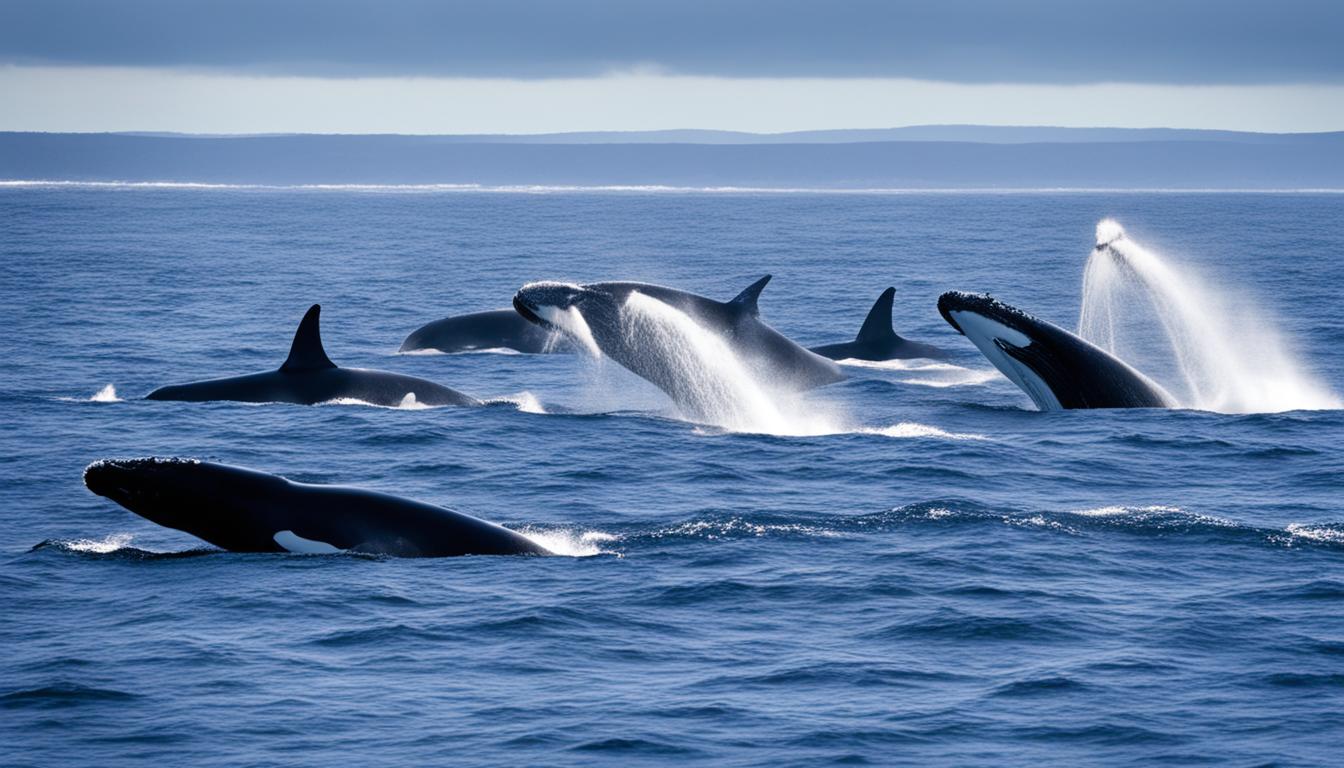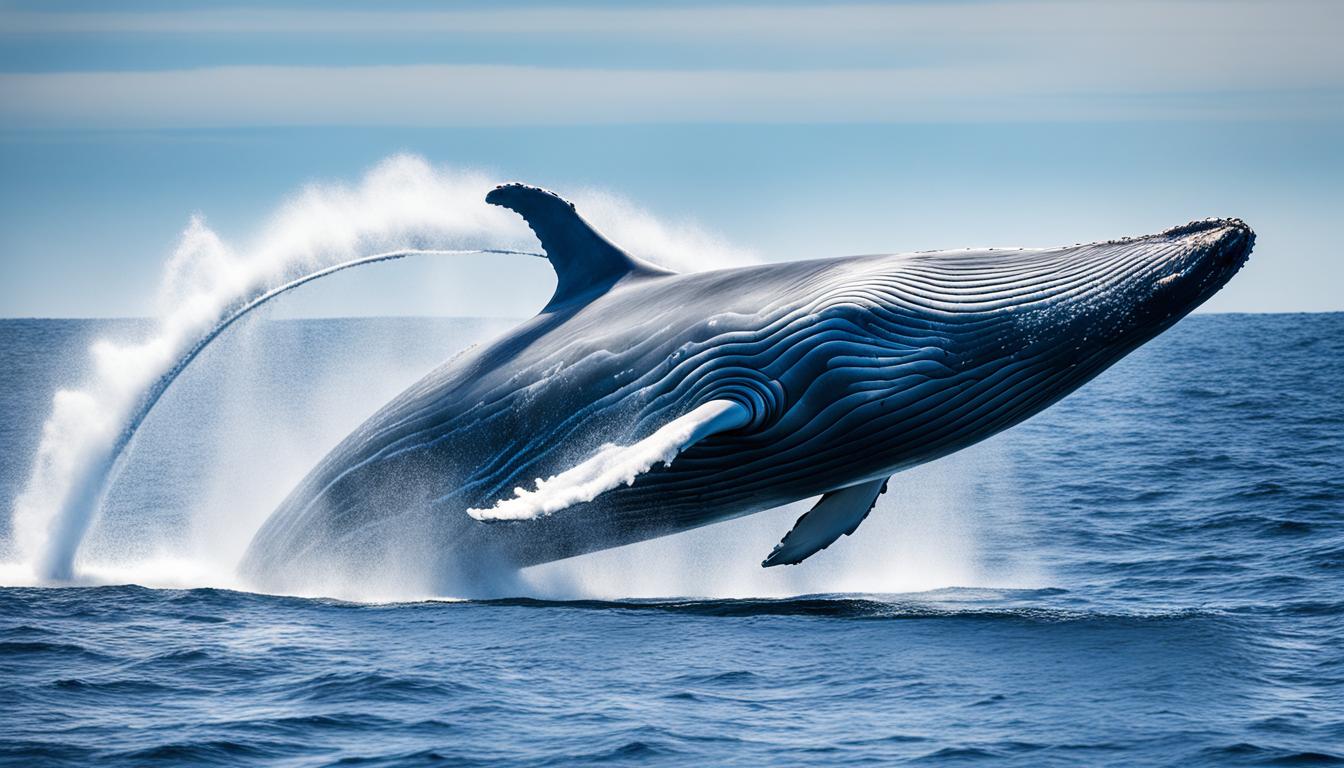Welcome to the world of marine life, where we’ll explore the largest species of jellyfish. These giants are not just big; they play key roles in the ocean. You’ll learn about different jellyfish, their homes, and why they matter in the sea. Get ready to discover the amazing world of these incredible creatures!
Introduction to Giant Jellyfish Species
Giant jellyfish are truly awe-inspiring with their huge size and special traits. They belong to the phylum Cnidaria and are key to marine ecosystems. Let’s dive into their biology, behavior, and where they live. You’ll learn cool jellyfish facts about their evolution and their place in the sea.
The lion’s mane jellyfish is a standout among giant jellyfish. It’s known for its long tentacles, showing the beauty of underwater wildlife. These creatures add to the rich diversity of marine life, proving how they’ve adapted to live among more complex beings.
Exploring giant jellyfish shows us the importance of the ocean’s balance. They help keep the oceans healthy and fascinate both scientists and fans. Their role in the food web highlights their key part in marine health.
| Characteristic | Description |
|---|---|
| Phylum | Cnidaria |
| Average Size | Up to 8 feet in diameter |
| Habitat | Open ocean and coastal waters |
| Diet | Plankton, small fish, and other marine organisms |
| Reproductive Method | Sexual and asexual reproduction |
What is the largest species of jellyfish?
The Lion’s Mane jellyfish, known as Cyanea capillata, is the biggest jellyfish around. It lives in the cold waters of the Arctic and northern Atlantic Oceans. This huge creature can grow up to 7 feet wide and has tentacles that stretch 120 feet long. It plays a big role in the ocean’s life.
Understanding the Lion’s Mane Jellyfish
The Lion’s Mane jellyfish is a marvel of nature, showing how big some jellyfish can get. It uses its size and long tentacles to catch food. It has special cells called cnidocytes that help it sting prey for food and defend itself.
Key Characteristics of the Lion’s Mane
Here are some things that make the Lion’s Mane jellyfish stand out:
- Bell Size: Its bell can be over 7 feet wide, making it a big sight.
- Tentacle Length: Its tentacles can reach up to 120 feet long, adding to its size.
- Coloration: It usually has a light pink to orange bell with darker edges.
- Habitat: It lives in cold waters, which help it grow and get big.
- Ecological Role: It is both a hunter and a food source for other sea creatures, affecting many ocean lives.
The Fascinating Life Cycle of Jellyfish
The jellyfish life cycle is a journey full of wonder. It shows the different stages these sea animals go through. Knowing this cycle helps us understand the complexity of jellyfish species and their importance in marine biology.
It starts with jellyfish laying eggs. These eggs get fertilized and turn into free-swimming larvae called planulae. These larvae float in the ocean, looking for a place to settle.
When they find a good spot, they turn into polyps. Polyps can stay like this for years. They can also make more jellyfish by budding, growing their numbers.
- Egg Stage: Fertilized eggs hatch into tiny larvae.
- Larval Stage: Free-swimming planulae find a substrate.
- Polyp Stage: Sessile organisms that can reproduce asexually.
- Medusa Stage: The mature jellyfish that we commonly recognize.
Polyps can change into many juvenile jellyfish through a process called strobilation. These young ones grow into medusae, the adult jellyfish we see in the ocean. This change is key in the jellyfish life cycle, as medusae help make more jellyfish.
Every part of the jellyfish life cycle is vital for their survival and growth. Jellyfish can adapt and reproduce in many ways, making them common in oceans all over the world.
The Zancleopsis grandis: A Newly Discovered Giant Jellyfish
The ocean has shown us again, with the finding of the Zancleopsis grandis. This new jellyfish was found by Peter Schuchert and Richard Collins off Florida’s coast. Their work, with 91 scuba dives, has added to our knowledge of marine life.
Research and Discovery
Researchers studied the Zancleopsis grandis deeply. They looked at its environment and how it behaves. This giant jellyfish is special because of its unique traits. Finding it makes us want to learn more about its role in the ocean.
Unique Features of the Zancleopsis grandis
The Zancleopsis grandis stands out with its big tentacles and unique look. These tentacles can be over two inches long. It also has a special color and shape that scientists are still learning about.
As scientists learn more about this jellyfish, we’ll hear more about it. This find shows us the wonders of the ocean. It makes us curious and reminds us to respect our oceans.
Comparing the Sizes of Various Jellyfish Species
The world of jellyfish is full of different species, each with its own size. By looking at their average sizes, we can see how diverse they are. In this section, we’ll explore the size differences between jellyfish like the Lion’s Mane and the Zancleopsis grandis.
Average Sizes of Giant Jellyfish
Giant jellyfish come in many sizes. Here’s a table that shows some of these species and their average sizes:
| Jellyfish Species | Average Size (Diameter) | Max Recorded Size |
|---|---|---|
| Lion’s Mane Jellyfish | 5-7 feet | 12 feet |
| Atlantic Sea Nettle | 1-3 feet | 5 feet |
| Moon Jellyfish | 1-2 feet | 3 feet |
| Zancleopsis grandis | Up to 10 feet | 15 feet |
Factors Affecting Jellyfish Size
Many things can affect how big jellyfish get:
- Environmental Conditions: Things like water temperature, salinity, and where they live can change their growth.
- Availability of Food: How much food they have affects their size and growth.
- Genetic Factors: Some jellyfish are just naturally bigger because of their genes.
Behavior and Diet of the Largest Jellyfish
The largest jellyfish, like the Lion’s Mane, show interesting ways to survive in the ocean. They have unique behaviors that help them in their underwater world.
They eat smaller fish, zooplankton, and sometimes other jellyfish. They catch their food with their long, stinging tentacles. These tentacles have cells called nematocysts that release toxins, making the food unable to move.
Jellyfish move through the water by pulsing their bell-shaped bodies. This lets them flow with ocean currents. It helps them stay in places with lots of food and nutrients.
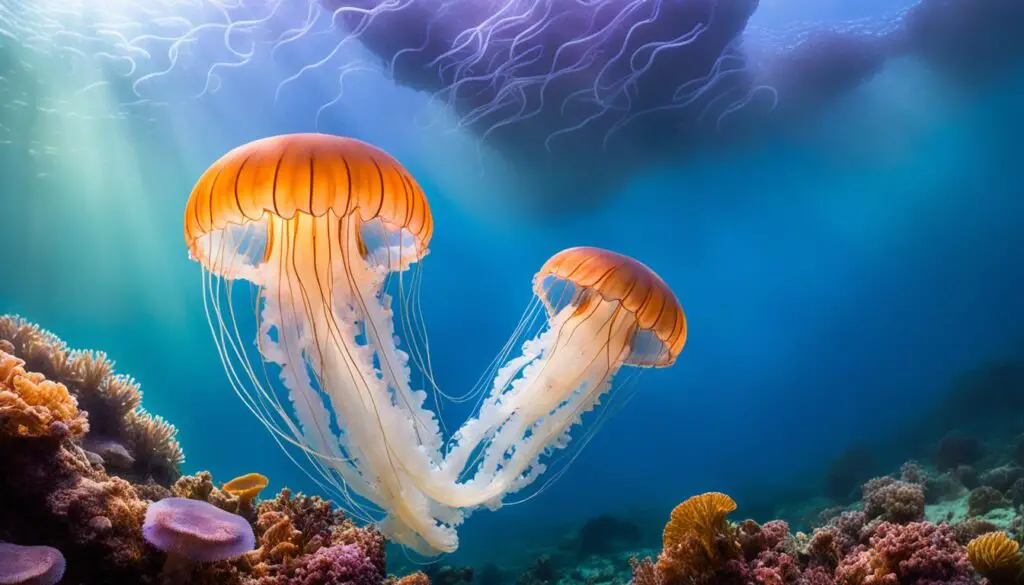
Learning about jellyfish behavior and what they eat helps us understand marine life better. These special traits help the jellyfish and affect the ocean’s ecosystem too.
Dangerous Encounters: Stings and Human Interaction
Meeting jellyfish can be risky for people who love the ocean. It’s key to know the dangers of jellyfish stings before you go to the beach or play in the water. The Lion’s Mane jellyfish is especially known for its painful stings. So, it’s vital to be aware of these risks.
Effects of Jellyfish Stings
Jellyfish stings can cause mild to severe reactions in humans. The venom can lead to redness, swelling, and even anaphylaxis in some cases. You might feel a burning sensation, muscle spasms, and nausea too, based on how sensitive you are.
When you get stung by a jellyfish, act fast. Rinse the area with vinegar to neutralize the toxins and stop more stinging. Don’t use fresh water, as it can make things worse by releasing more venom.
Learning about the effects of jellyfish stings helps you stay safe in the ocean. Knowing these dangers can make your beach trips more enjoyable and secure.
Conservation and Protection of Jellyfish Species
Jellyfish conservation is key as they face threats from climate change and habitat loss. Protecting them helps their survival and the ocean’s health. Jellyfish are important in the ocean, serving as both food and predators.
Worldwide, efforts are made to save jellyfish habitats. This includes creating protected marine areas and promoting sustainable fishing. Awareness campaigns teach people why jellyfish matter. By protecting marine species, we learn about jellyfish’s role in healthy ecosystems.
Learning about jellyfish and their importance can help you support their conservation. The future of jellyfish and marine life needs our collective action. We must push for policies that protect these amazing creatures and their homes.

